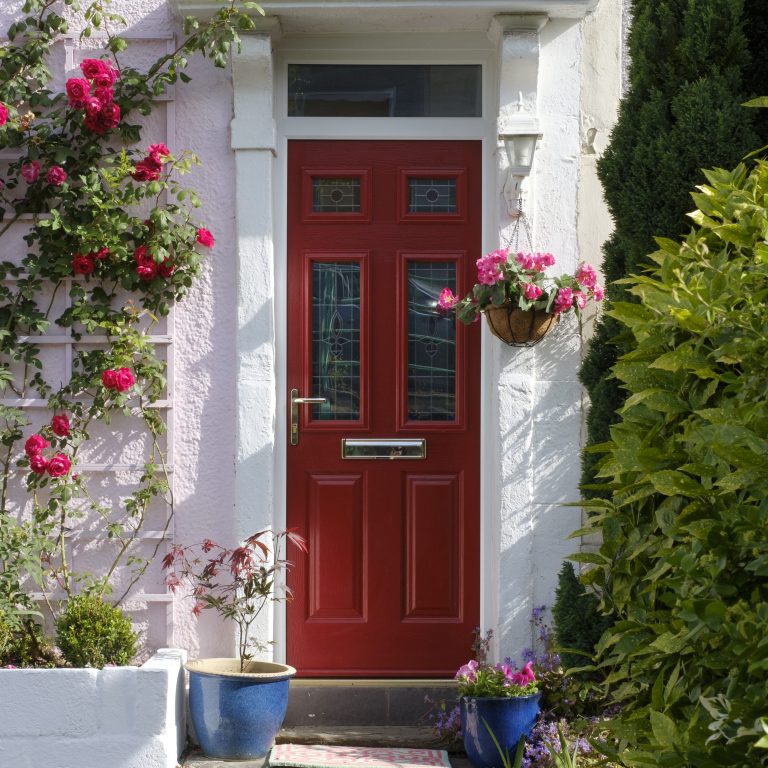A lot of homeowners these days struggle to find a traditional aesthetic, mainly because they don’t know what “traditional” actually looks like. What makes it more confusing is that traditional aesthetics range from timber-look doors to the brightest colors we have on hand. Luckily, after many years of building traditional composite doors of our own, we’ve got some pointers. All you need to do, is differentiate between “modern traditional” and “natural traditional” as well as what components complement the aesthetics of your door.

A Modern Example Of Traditional Front Doors: When opting for a modern traditional door, you almost certainly do not choose a timber-look skin, instead opting for a wood grain texture to give the natural touch a traditional front door tends to. Since we’re opting not to have timber skin doors, the colour you choose has to be as rich as it can be. To give you a better example, on our colour sample page, when you find the red option, it’s already set to a rich red wood grain texture, which would perfectly offset any component you give it.
Speaking of which, the components you choose make the biggest difference to the overall aesthetics of your entryway. Although we offer some of the widest varieties of components in the industry, traditional aesthetics require traditional metal. For a traditional door, we recommend opting for any of our urn-style knockers, or even a bullring knocker. In almost every instance of coloured doors trying to stay traditional, the components are almost always made from the classic metallic chrome look. The only exception to this rule is when you choose a black-colored door, then in which case, we wholeheartedly recommend gold. This creates a bold look that almost looks noir style, yet still as traditional as it gets.
Finally, to complete the overall aesthetic, you need to visit the paneling and glazing patterns with a keen eye. For both the modern and naturally traditional doors, we recommend looking at our classic range with a focus on styles that feature tall and slim panels and glazing that accentuate the overall height of your door. Our suggestion for modern tradition, have a look at the Etna, Scafell, and Monte Viso styles. Each has a different place in the scale between glazing and paneling without compromising the overall look and feel of traditional doors.
A Naturally Traditional Aesthetic For Composite Doors: On the opposite side of tradition, a natural aesthetic, calls for a natural style. We have 3 different wood style colour samples; Irish Oak, Golden Oak, and Rosewood. The difference between a natural traditional look and a modern traditional look is that the natural aesthetic is much less reliant on contrast in order to look traditional. You can afford to allow the door to blend with the components attached to it, and allow it to blend in with the rest of your home.
With naturally traditional doors, you can choose the components that complement instead of offset the colour, so you can branch out your component colour schemes to antique black, graphite, and chrome as a great colour combination for your composite front door.

Furthermore, when opting for a natural traditional aesthetic, consider the paneling and glazing patterns that enhance the organic feel of the door. Styles like “Scaffel” and “Monte Viso” still hold relevance here, but with with a naturally traditional front door, it’s best to choose a style that accentuates the overall organic look of the door. So choosing styles that bring out the wooden aesthetic like “Cheviot” or “Skiddaw” out of the Classic Range allows you to catch the eye of any on-looker using its glazing, but allows the rest of the door to blend into the aesthetic of your home.
Designing traditional front doors involves a careful balance of elements that evoke a sense of timelessness and familiarity. Whether you lean towards a modern interpretation with rich colors and sleek metallic accents, or embrace the natural allure of wood finishes and complementary components, the key lies in understanding the nuances of traditional aesthetics and tailoring them to suit your individual preferences. With attention to detail and an eye for classic design principles, you can create an entryway that not only enhances the curb appeal of your home but also welcomes guests with a timeless charm that never goes out of style.








